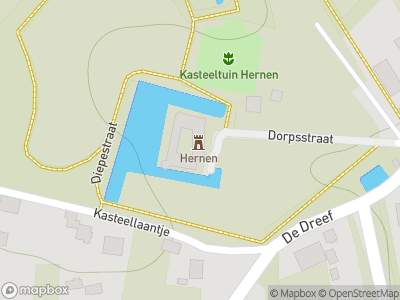Hernen was one of the many ‘heerlijkheden‘ (seigniories) in the Land van Maas en Waal region. A seigniory usually included a fortified house or castle surrounded by a large area of land.
Motte
The origins of Hernen lie to the west of the present castle, next to the river Elst. That is where the first motte castle of Hernen was sited, and remained in use until the 12th/13th century. This was possibly also the fortress of the Lords of Hernen, who first appear in the records in 1247. The lord received income through taxes and special privileges, such as the milling rights. This income enabled him to extend his castle, which in turn increased his status.
Castle
Around that time, Hernen was partly in Cleves and partly in Gelderland. In the 14th century, work started on the construction of the present castle, which was sited on the Gelderland part. Later, everything came again under one estate. The east wing and the monumental entry gate date from 1555. A special feature is the covered patrol path – quite rare in the Netherlands.
Preserved
The castle never suffered war damage or natural disasters. In the last century, the lord of the castle hardly ever lived there, leaving the administration to a steward. There was no urge to embellish the castle according to the latest fashion in architecture, and consequently the castle was able to keep its austere, medieval character.
Church
Not far from the castle stands Hernen church. Between these two buildings, the lord of the castle had an avenue of lime trees planted to provide a protected and shaded walk to church. The present neo-romantic church stands on the spot of the old medieval church, which was demolished in 1892. The present-day village of Hernen arose around the church.
“















